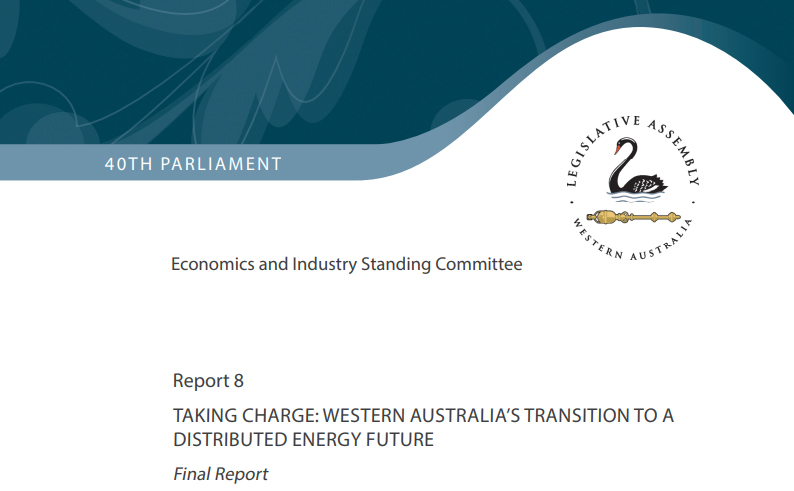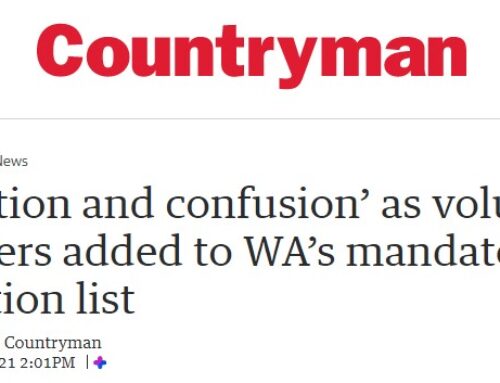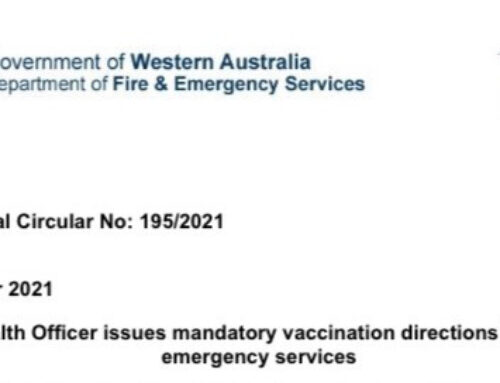The following was submitted by DFES Commissioner Darren Klemm to an inquiry undertaken by the Economics and Industry Standing Committee of Parliament into Microgrids and Associated Technologies in WA. The final report may be accessed here.
Bushfire Volunteers generally supports the DFES submission, but notes:
- While Microgrids hold the promise of reducing bushfire risk by reducing the number of long distribution lines in remote bushfire prone areas, there will undoubtedly be consequences of what we see as the inevitable introduction of multiple, non-government third parties with responsibility for the operation, maintenance, control and repair of individual power systems.
- For efficiency, it is likely that Microgrids will operate with minimal spare capacity. During an emergency such as a major bushfire, sustained increased demand from water pumps and other equipment could cause a Microgrid to fail, cutting power to the whole region.
- The association again asserts that Bush Fire Brigades with a need and willingness must be able to access Breathing Apparatus, underscored by the Commissioner’s comments about the need for Breathing Apparatus to be available to Brigades turning out to a fire within a local BESS (Battery Energy Storage System).
SUBMISSION TO INQUIRY INTO MICROGRIDS AND ASSOCIATED TECHNOLOGIES IN WESTERN AUSTRALIA
Thank you for the opportunity for the Department of Fire and Emergency Services (DFES) to make a submission to the Committee’s Inquiry into Microgrids and Associated Technologies in Western Australia.
Across Australia, electricity networks are undergoing a historic transformation. Both Standalone Power Systems (SPS) and Microgrids will play important roles in this transformation. As new services and technology become mainstream, there will be an increasing opportunity for electricity customers to move completely off the grid, or to never connect in the first place.
The focus of this submission is on the potential implications of microgrids and associated technologies on bushfire risk management.
Bushfire Risk
Microgrids may also enable power network managers to better balance the voltage of the lines and therefore reduce the incidence of power spikes that can cause network infrastructure to fail and become potential ignition sources for bushfires.
Microgrids may enable power network managers to decommission long distribution lines in remote bushfire prone areas and therefore remove this source of bushfire ignitions.
As discussed below, the potential fire hazards associated with the installation and maintenance of Battery Energy Storage Systems must be considered.
The ability of microgrids to isolate from the larger electricity grid may enable the faster recovery of power supplies after a bushfire or other natural hazard event and therefore provide an improved level of resilience for the community.
Microgrid configurations and SPS do have the potential to contribute to an overall bushfire risk reduction strategy especially in regional and “edge of grid” communities that have long sections of network infrastructure that cross rural areas, which have been installed to connect customers to remote generation sources. With the establishment of microgrid power services, retirement of these long, interconnecting power lines would remove the possibility of objects like vegetation, animals and tree branches hitting powerlines which may create sparks that can fall to the ground and ignite dry grass.
Battery Energy Storage Systems
Battery Energy Storage Systems (BESS) play an important role in SPS and microgrid systems. BESS are being installed in increasing numbers in electricity distribution networks, homes, remote area power supplies and commercial/industrial installations. BESS may consist of a number of externally located battery arrays, inverters and isolation points in a fenced compound adjacent to a wind or solar farm and electrical substation.
These grids may however provide greater resilience to events due to a more robust network that can maintain electrical supply for water pumps or communication towers. Microgrids are areas that supplement their electricity power supplies with renewable energy with the capability for battery storage. These areas then use their own electricity and any power not used will be put into the grid.
The benefit is that the area has a guaranteed continual electricity supply either from their own source or from the main grid. Unless they are a standalone microgrid in which case they are completely separated from the main grid. There is still a requirement to be connected to the main grid so the infrastructure for the electricity supply will not change.
Potential fire hazards associated with the installation and maintenance of a BESS include:
- External mechanical damage (i.e. impact to the enclosing cabinets into the further enclosed battery pods, causing structure to structure fire spread (thermal runaway).
- Electrical failure of equipment causing internal-initiated thermal runaway or ignitions of external fuel sources.
- External fire impact such as from a bushfire/grass/stubble fire.
Additional observations:
- Fire service response to an incident involving charged BESS will be limited as there is no way to effectively stop a runaway exothermic failure in a damaged BESS until it is electrically discharged. Generally this may mean letting the BESS discharge at its own pace and protecting other things around it. It is also noted that the nature of the electrolyte used for a range of battery chemistries can lead to various hazardous materials in the fire, smoke and runoff.
- The risk of mechanical damage is minimal and on-board auto-shutdown systems would limit electrical overload/arcing hazards.
- Considering the potential of internal thermal runaway from battery cabinet to battery cabinet, significant volumes of on-site water will be required to be deployed on the impacted cabinet(s) to restrict the propagation of thermal runaway.
- It should be acknowledged that some gas venting from cabinets under fire impact would occur and this will likely freely vent and disperse to atmosphere, however the requirement of a fire service breathing apparatus response should be considered.
The selection of the location of a BESS should take the following into account:
- Any installation of a BESS in a bushfire prone area will need to be assessed under State Planning Policy 3. 7: Planning in Bushfire Prone Areas and satisfy the bushfire protection criteria within the associated Guidelines.
- The location of the installation should be a significant distance from any areas of extreme bushfire hazard.
- The impact of a bushfire would be mitigated with adoption of an appropriate site layout, construction materials and design, and an Asset Protection Zone including the management of defendable space and combustible material within the site compound.
- Safe and efficient access for emergency services will be required.
Service Reliability during Bushfire Events
For “edge of grid” and some regional customers, microgrids would be of benefit to the town, allowing it to be islanded if the long rural feeder line supplying power was affected by a bushfire. The town would be able to continue operating with normal or slightly reduced power consumption levels for a period of time depending on the type of generation being used in the islanded state. However, if the bushfire moved toward the town and the associated network infrastructure, then there would be little to no benefit in a microgrid.
In areas around the scarp and high bushfire risk areas in the metropolitan area, microgrids would not increase the overall benefit of existing bushfire mitigation programs -covered conductors, vegetation management, anti-conductor clash devices that are installed on powerlines and other assets.
Cases such as the Waroona Fires have demonstrated that power infrastructure can be very vulnerable during a bushfire and can result in the loss of service over an extended area for hours, days and even weeks.
During a bushfire event, households and businesses rely on having power in order to receive warnings and advice from fire authorities via the internet, radio or telephone. Loss of power can also leave landowners unable to actively defend their properties if they do not have a water supply with an independent power source.
During high risk bushfire weather conditions, power utilities adopt a precautionary approach when their systems experience an outage. Before turning the power back on after any outage, power crews must patrol the powerlines to find the cause of the fault. Some regional powerlines are hundreds of kilometres long, so this can take considerable time. In cases in which a Total Fire Ban or Vehicle Movement Ban has been declared, power utilities usually have to wait for bushfire risk conditions to ease or the bans to be lifted before they can patrol their powerline or attempt to restore power. This can increase the duration of the power outage.
One of the advantages promoted with microgrids is increased reliability as the area affected by a network fault can be limited through the islanding of microgrids from the main network and switching to a local generation/storage scenario.
There is anecdotal evidence from the 2017 wildfires in northern California’s wine country that SPS and microgrids can be effective in maintaining power during bushfire events. The most commonly cited case is that of Stone Edge Farm . Through a single facility smart microgrid, power supply to the vineyard operation was maintained throughout the fire event while the fire knocked out the wider power grid. This allowed the property owners to continue to operate their irrigation equipment remotely to protect and preserve the vineyard from the fire.
DFES, like the community, relies on power provision. Communities are developing an awareness of the risk to communications arising from power outages, particularly as telephony services are shifting to mobile services with the roll-out of the national broadband network. Microgrids could offer some redundancy to communications services within local communities.
It should be noted that, while such anecdotal evidence is promising, rigorous studies of the reliability and resilience of SPS and microgrids during bushfire events is limited at this time.
Yours sincerely
Darren Klemm
Commissioner






